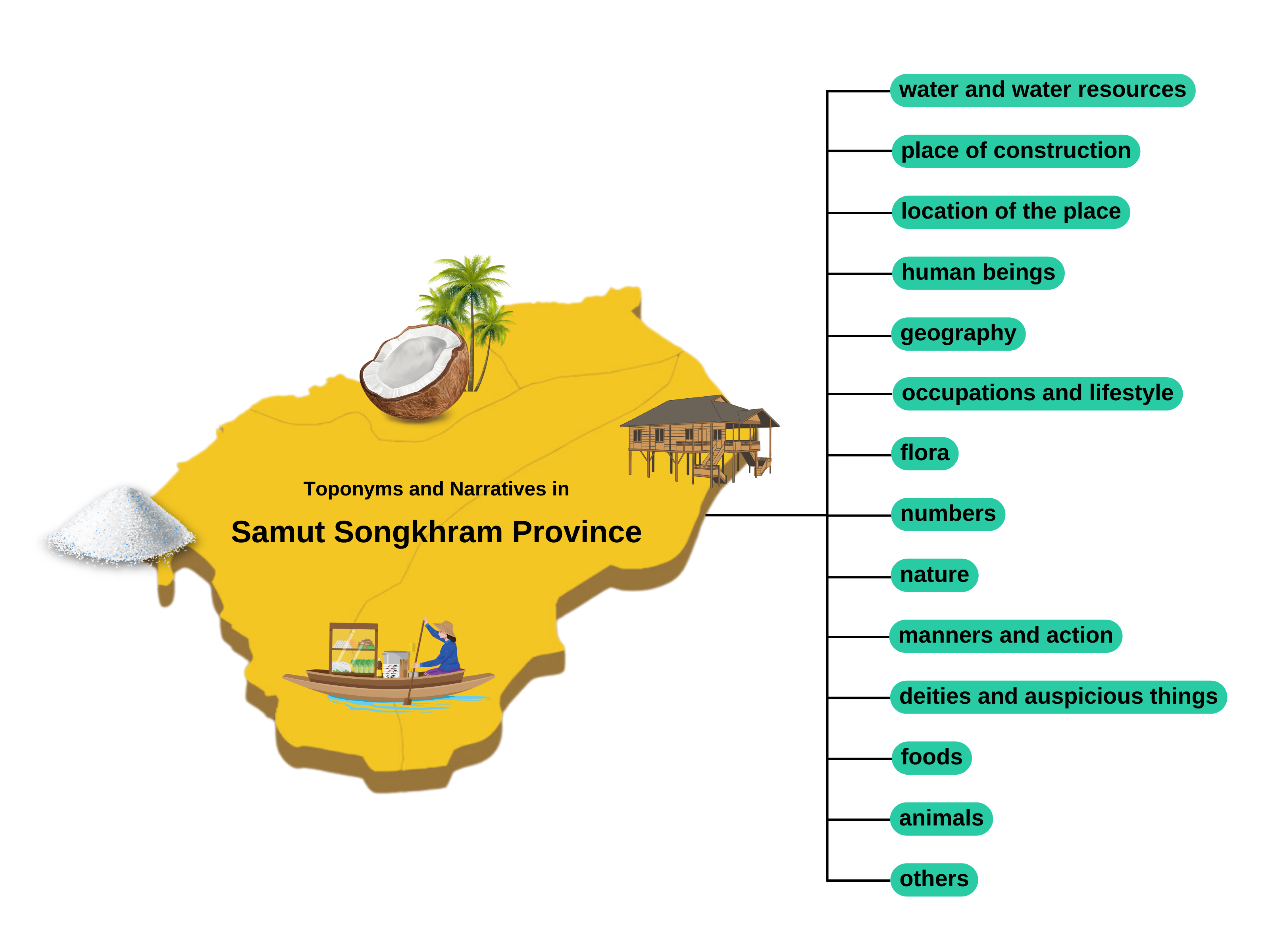Toponyms and Narratives in Samut Songkhram Province
Main Article Content
Abstract
Objectives: This article aimed at investigating meanings and origins of toponyms (village names) and analyzing the contents of narratives of the place names in Samut Songkhram Province.
Methods: Semantic fields was used to investigate meanings and origins of village names, while conventional content analysis was adopted to analyze the contents of narratives of the place names in Samut Songkhram Province.
Results: The findings revealed that there were 14 types of the meanings of the village names: 1) water and water resources, 2) place of construction, 3) location of the place, 4) human beings, 5) geography, 6) occupations and lifestyle, 7) flora, 8) numbers, 9) nature, 10) manners and action, 11) deities and auspicious things, 12) foods, 13) animals, and 14) others. Interestingly, the village names are related to socio-cultural contexts and the geography of the area. For the narratives of the place names, 11 issues were found in the contents which can be categorized into four groups: 1) narratives related to historical events, 2) narratives related to lifestyle of the communities in the past, 3) narratives related to nature of the places, and 4) narratives related to the belief system of the communities.
Application of this study: The findings indicated that village names and their narratives can serve as resources which can be applied to create value for the well-being of local people in the community and develop sustainable tourism in Samut Songkhram Province.
Downloads
Article Details

This work is licensed under a Creative Commons Attribution-NonCommercial-NoDerivatives 4.0 International License.
References
Boas, F. (1964). On geographical name of the Kwakiutl Indians. In Hymes, D. (Ed.), Language in Culture and Society, pp. 1858-1942, New York: Harper & Row.
Buanil, W. (1993). Compare the classification of names of water resources in 6 provinces in the central and northeastern regions. Master Thesis, Thammasat University, Thailand. (In Thai)
Buaon, C. (2019). Perceived image and destination story: A case study of golden mermaid sculpture, Songkhla Province. Master Thesis, M.A. in Marketing, Prince of Songkla University, Thailand. (In Thai)
Deepadung, S. (2004). Toponyms in the western region of Thailand: Kanchanaburi, Nakhonpathom, Prachuapkhirikhan, Phetchaburi, Ratchaburi, Suphanburi, Samutsongkhram, and Samutsakhon. Nakhon Pathom: Research Institute for Languages and Cultures of Asia, Mahidol University. (In Thai)
Dinlansakul, M. (2011). The name of the house and the city: Stories of people’s lives and the Songkhla lake basin community (Research Report). Songkhla: Faculty of Humanities and Social Sciences, Thaksin University. (In Thai)
Editorial Department Nai Rob Roo, & Wimuttaset, J. (2012). Samut Songkhram. Bangkok: Sarakadee Press.
Hsieh, H.-F., & Shannon, S. E. (2005). Three approaches to qualitative content analysis. Qualitative Health Research, 15(9), 1277-1288.
Jerry, W. G. (1984). Toponyms in Eastern and Southern Thailand: A preliminary study of village names in Chonburi, Rayong, Chantaburi and Trat. Science of Language, 4, 1-35. (In Thai)
Jirananthanaporn, S., & Singnoi, U. (2004). Linguistic structure of villages in Phitsanulok Province. Language and Linguistics, 23(2), 75–94. (In Thai)
Jitnupong, S. (2015). The white blood lady: Legend and the creation of cultural products. Asian Journal of Arts and Culture, 15(1), 135-143. (In Thai)
Juangtrakul, J., & Wongprasit, N. (2019). Content analysis for data analysis in qualitative research. PAAT Journal, 2(2), 1-14. (In Thai)
Kullawanit, P. (1992). Village names in Guangxi Province and Northeastern Thailand. Bangkok: Chulalongkorn University Printing House.
Lehrer, A. (1974). Semantic field and lexical structure. Amsterdam: North-Holland.
Lekhakul, K. (2013). Mae Klong City Samut Songkram. Bangkok: Dansutha Publishing.
Ministry of Culture of Thailand. (2012) Wat Don Manora. M-Culture Data Standard. Retrieved 20 January 2027, from http://www.m-culture.in.th/album/36560
Mongkolsiri, T., Suthamdee, A., & Ruengrong, A. (2022) Narratives and the creation of King Taksin the Great’s worshipping rituals: A case study from Wat Hong Rattanaram Temple, Bangkok Yai District, Bangkok. Liberal Arts Review, 17(2), 97-113. (In Thai)
Mulmanee, S. (2021). Local narratives of Chanthaburi: The relation of space construction for eco-tourism management in Chanthaburi. Wiwitwannasan, 5(3), 337-358. (In Thai)
Palmer, G. B. (1990). ‘Where there are muskrats’: The semantic structure of Coeur d’ Alene place names. Anthropological Linguistics, 32(3-4), 263-294.
Phongsabut, P. (1988). Geographic words that describe local topographic features in Thailand. Geography, 13(1), 5-11. (In Thai)
Phongsawat, C. (2019). Study to the explanation of place background and place names in Ayutthaya in the legends of Chao Mae Soi Dok Mak. Journal of Ayutthaya Studies Institute (JAS), 11(1), 25-31. (In Thai)
Piyapakorn, P. (1989). Landscapes of rural villages in Chaiyaphum Province. Geography, 14(3), 177-182. (In Thai)
Premsrirat, S., & Khamhiran, S. (1984). Village name of Mueang Surin District. Nakhon Pathom: Research Institute for Languages and Cultures of Asia, Mahidol University. (In Thai)
Rattanapakdee, O., & Klinbubpa, W. (2007). Toponyms in Lamphun Province: Village names. Humanities Journal, 17(1), 58-84. (In Thai)
Rattanapakdee, O., & Klinbubpa, W. (2010). Toponyms in Lampang Province: Village names. Journal of the Faculty of Arts, Silpakorn University, 31(2), 26–61. (In Thai)
Rongheep Subdistrict Administrative Organization. (2017) Rongheep. Retrieved 20 January 2027, from http://www.rongheep.go.th/site/
Salzmann, Z. (1990). Toponymy of the Bigar Region in the Romanian Banat. Anthropological Linguistics, 32(1-2), 120-138.
The Royal Institute. (2013). Royal dictionary 2011, in honor of His Majesty King Bhumibol Adulyadej on the auspicious occasion of the 7th royal birthday celebration, 5 December 2011. Bangkok: The Royal Institute. (In Thai)
Waengso, A., Thawongsa, K., & Nanthaprom, M. (2022). Ecological story telling with creating cultural landscape in Bueng-Karn community. Journal of MCU Ubon Review, 6(3), 1021-1032. (In Thai)
Walyaphet, M. et al. (1979). Geographic study of topographical names of Nakhon Pathom Province (Research Report). Nakhon Pathom: Department of Geography, Faculty of Arts, Silpakorn University. (In Thai)
Worahan, S. (2019). Narrative of royal temple in Ubon Ratchathani Wat Si-Ubonrattanaram: The Increase of cultural asset to enhance tourism value. Humanities and Social Sciences Journal, Ubon Ratchathani Rajabhat University, 8(1), 386-404. (In Thai)


